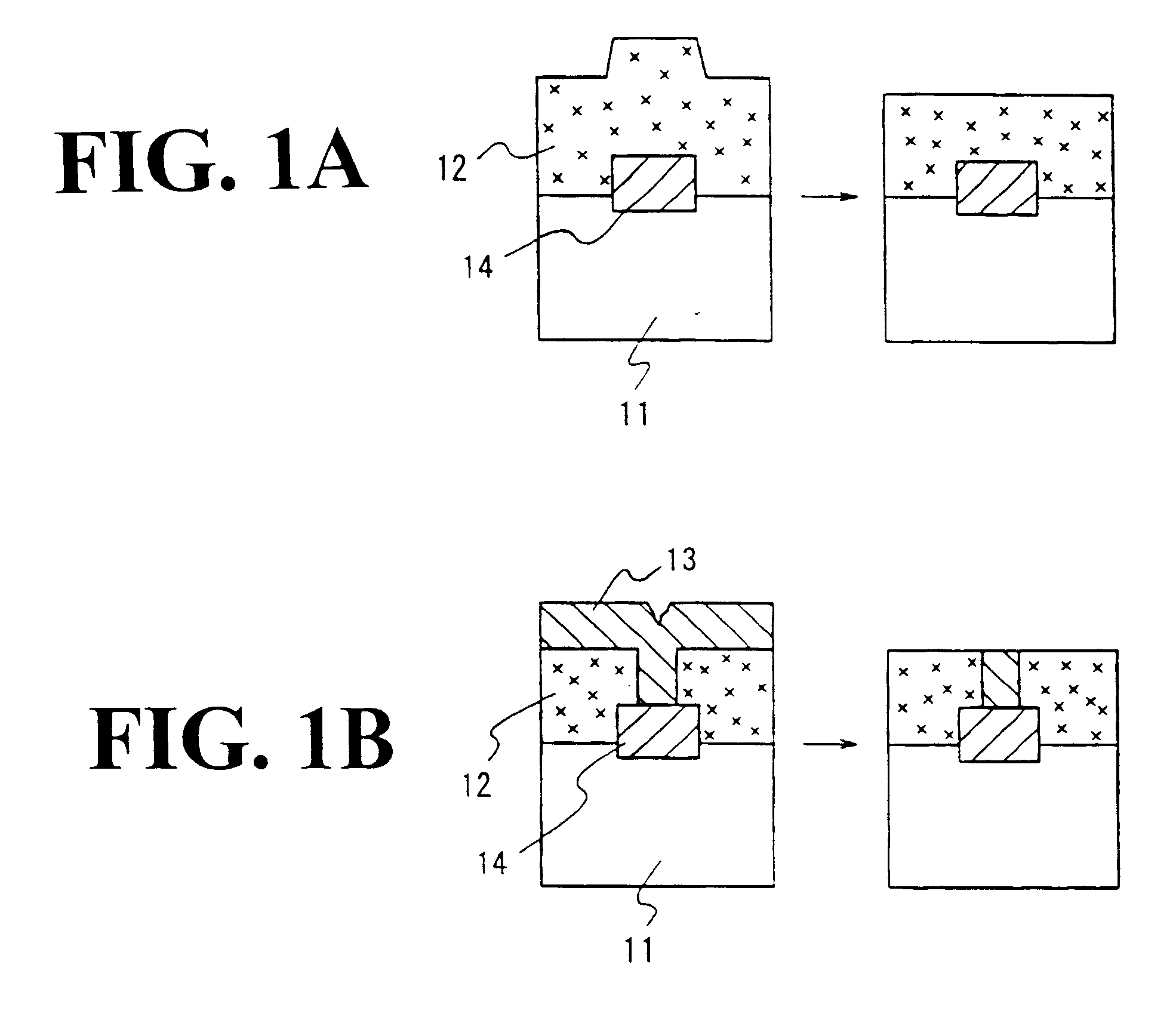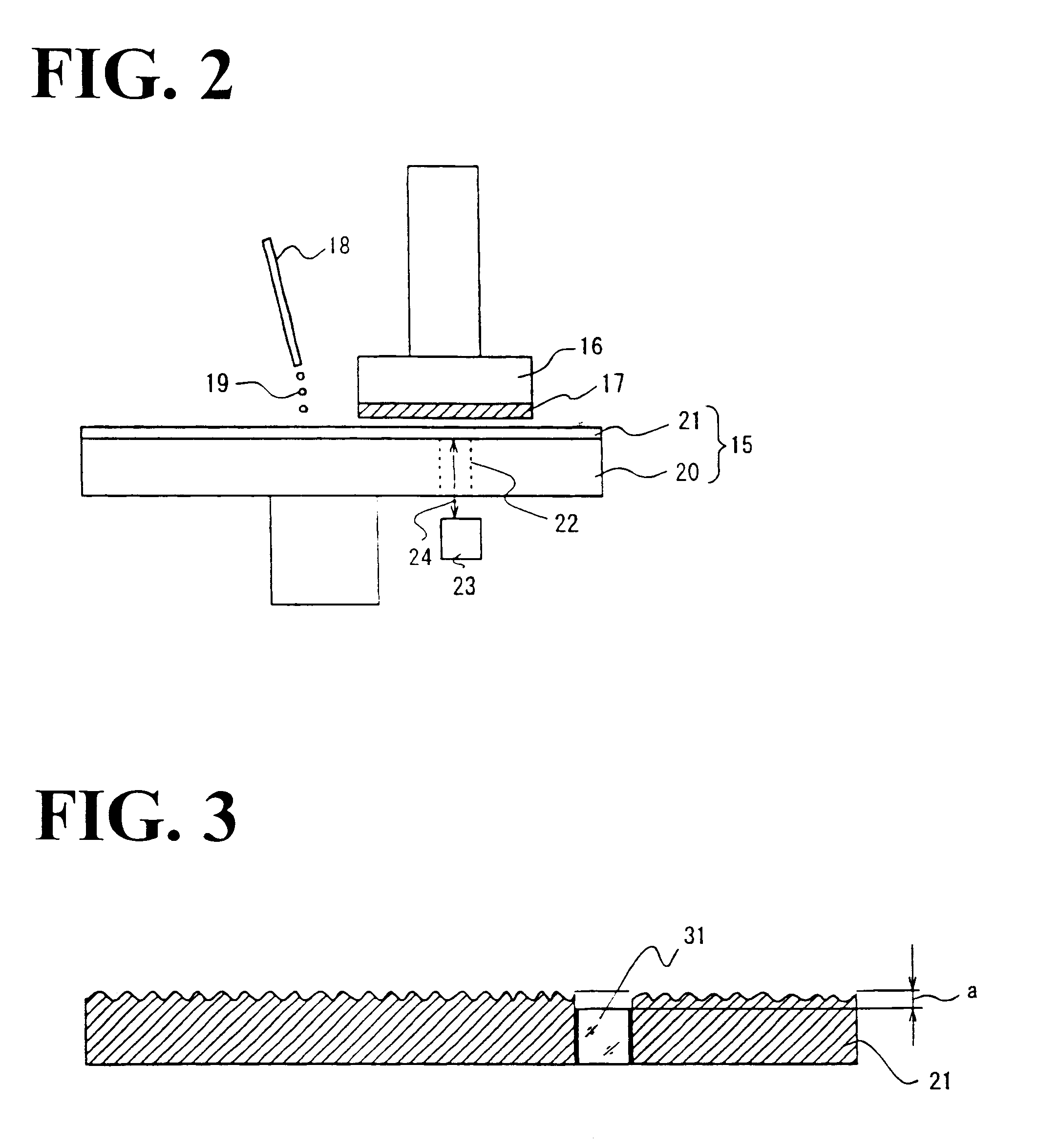Polishing body, polishing apparatus, polishing apparatus adjustment method, polished film thickness or polishing endpoint measurement method, and semiconductor device manufacturing method
a technology of polishing apparatus and polishing body, which is applied in the direction of grinding machine components, manufacturing tools, lapping machines, etc., can solve the problems of wiring interruption and electrical capacitance drop, individual semiconductor manufacturing process processes become more numerous and complicated, and the surface of semiconductor devices is not always fla
- Summary
- Abstract
- Description
- Claims
- Application Information
AI Technical Summary
Problems solved by technology
Method used
Image
Examples
example 1-2
FIG. 4 is a diagram which is used to illustrate a second example of a polishing pad (polishing body) of the present invention. FIG. 4(a) is a plan view, FIG. 4(b) is a sectional view of the portion indicated by line A-O in FIG. 4(a), FIG. 4(c) is a sectional view of the portion indicated by line B-O in FIG. 4(a), and FIG. 4(d) is a sectional view of the portion indicated by line C-O in FIG. 4(a). In FIG. 4, 31a through 31c indicate window plates, and 32a through 32c indicate opening parts.
In the present example, the polishing body 21 has three opening parts 32a, 32b and 32c. Furthermore, a window plate 31a is disposed in the opening part 32a, a window plate 31b is disposed in the opening part 32b, and a window part 31c is disposed in the opening part 32c. In FIGS. 4(b), (c) and (d), the surface on the upper side of the polishing body 21 is the top surface of the polishing body 21, and the surfaces on the upper sides of the window plates 31a through 31c are the surfaces of the window...
example 1-3
FIG. 5 is a diagram which is used to illustrate a third example of a polishing pad (polishing body) of the present invention. FIG. 5(a) is a plan view, and FIG. 5(b) is a sectional view of the portion indicated by line D-E in FIG. 5(a). In FIG. 5, 32 indicates an opening part, and 33a through 33c indicate respective parts of a window plate 31.
The polishing body 21 of the present example has a single opening part 32. The window plate 31 disposed in this opening part 32 has a step-form cross section, so that the amount of recess of the surface of the window plate 31 on the side of the object of polishing with respect to the surface of the polishing body 21 differs in the three parts 33a, 33b and 33c. The amount of recess of the surface of the window plate 31 on the side of the object of polishing with respect to the surface of the polishing body 21 is smallest in the part 33a, and largest in the part 33c. In the part 33b, this amount of recess is more or less intermediate between that...
example 1-4
FIG. 6 is a diagram which is used to illustrate a fourth example of a polishing pad (polishing body) of the present invention. FIG. 6(a) is a plan view, and FIG. 6(b) is a sectional view of the portion indicated by line F-G in FIG. 6(a). In FIG. 6, 34a through 34d are points on the surface of the window plate 31.
The polishing body 21 of the present example has a single opening part. The parallel flat-plate window plate 31 installed in this opening part is devised so that it is inclined in section, with the amount of recess from the surface of the polishing body varying in the F-G direction in FIG. 6(a). As a result, the amount of recess of the surface of the window plate 31 on the side of the object of polishing varies in a continuous manner. In a case where four places 34a, 34b, 34c and 34d are designated on the surface of the window plate 31, the amount of recess of the surface of the window on the side of the object of polishing with respect to the surface of the polishing body i...
PUM
| Property | Measurement | Unit |
|---|---|---|
| thickness | aaaaa | aaaaa |
| thicknesses t1 | aaaaa | aaaaa |
| diameter | aaaaa | aaaaa |
Abstract
Description
Claims
Application Information
 Login to View More
Login to View More - R&D
- Intellectual Property
- Life Sciences
- Materials
- Tech Scout
- Unparalleled Data Quality
- Higher Quality Content
- 60% Fewer Hallucinations
Browse by: Latest US Patents, China's latest patents, Technical Efficacy Thesaurus, Application Domain, Technology Topic, Popular Technical Reports.
© 2025 PatSnap. All rights reserved.Legal|Privacy policy|Modern Slavery Act Transparency Statement|Sitemap|About US| Contact US: help@patsnap.com



